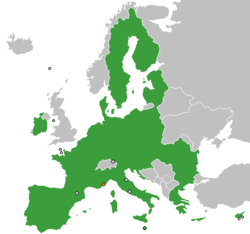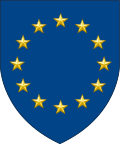Monaco–European Union relations
Relations between the Principality of Monaco and the European Union (EU) are primarily conducted through France. Through that relationship Monaco directly participates in certain EU policies. Monaco is an integral part of the EU customs territory and VAT area, and therefore applies most measures on excise duties and VAT.[1] Monaco borders one EU member state: France. However this relationship does not extend to external trade. Preferential trade agreements between the EU and third countries apply only to goods originating from the customs territory – Monaco may not claim EU origin in this respect.[1]
 | |
EU |
Monaco |
|---|---|
Monaco is a de facto member of the Schengen area (its borders and customs territory are treated as part of France) and it officially uses the euro as its sole currency. It uses the euro via an agreement with the EU and France and is allowed by the EU to mint its own coins. Monaco uses the euro as it previously had its currency tied 1:1 with the French franc.[1]
The two have also concluded agreements on the application of Community legislation to pharmaceuticals, cosmetic products and medical devices (this entered into force on 1 May 2004); and on savings taxation (in force since 1 July 2005).[1]
Future integration
EU membership for Monaco is unlikely as, aside from its size, unlike the constitutional monarchies within the EU, the Prince of Monaco has considerable executive powers and is not merely a figurehead.
Monaco joined the Council of Europe in 2004,[2] a move that required it to renegotiate its relations with France, which previously had the right to nominate various ministers. This was seen as part of a general move toward Europe.[3]
In November 2012, after the Council of the European Union had called for an evaluation of the EU's relations with the sovereign European microstates of Andorra, Monaco and San Marino, which they described as "fragmented",[4] the European Commission published a report outlining options for their further integration into the EU.[5] Unlike Liechtenstein, which is a member of the European Economic Area (EEA) via the European Free Trade Association (EFTA) and the Schengen Agreement, relations with these three states are based on a collection of agreements covering specific issues. The report examined four alternatives to the current situation: 1) a Sectoral Approach with separate agreements with each state covering an entire policy area, 2) a comprehensive, multilateral Framework Association Agreement (FAA) with the three states, 3) EEA membership, and 4) EU membership. The Commission argued that the sectoral approach did not address the major issues and was still needlessly complicated, while EU membership was dismissed in the near future because "the EU institutions are currently not adapted to the accession of such small-sized countries." The remaining options, EEA membership and a FAA with the states, were found to be viable and were recommended by the Commission. In response, the Council requested that negotiations with the three microstates on further integration continue, and that a report be prepared by the end of 2013 detailing the implications of the two viable alternatives and recommendations on how to proceed.[6]
As EEA membership is currently only open to EFTA or EU members, the consent of existing EFTA member states is required for the microstates to join the EEA without becoming members of the EU. In 2011, Jonas Gahr Støre, the then Foreign Minister of Norway which is an EFTA member state, said that EFTA/EEA membership for the microstates was not the appropriate mechanism for their integration into the internal market due to their different requirements than large countries such as Norway, and suggested that a simplified association would be better suited for them.[7] Espen Barth Eide, Støre's successor, responded to the Commission's report in late 2012 by questioning whether the microstates have sufficient administrative capabilities to meet the obligations of EEA membership. However, he stated that Norway was open to the possibility of EFTA membership for the microstates if they decide to submit an application, and that the country had not made a final decision on the matter.[8][9][10][11] Pascal Schafhauser, the Counsellor of the Liechtenstein Mission to the EU, said that Liechtenstein, another EFTA member state, was willing to discuss EEA membership for the microstates provided their joining did not impede the functioning of the organization. However, he suggested that the option of direct membership in the EEA for the microstates, outside of both the EFTA and the EU, should be given consideration.[10]
On 18 November 2013 the EU Commission published their report which concluded that "the participation of the small-sized countries in the EEA is not judged to be a viable option at present due to the political and institutional reasons", but that Association Agreements were a more feasible mechanism to integrate the microstates into the internal market, preferably via a single multilateral agreement with all three states.[12] In December 2014 the Council of the European Union approved negotiations being launched on such an agreement,[13] and they began in March 2015.[14]
References
- The EU's relations with Monaco, European External Action Service, September 2011
- "Background Note: Monaco". Department of State. March 2006.
- "Monaco admis au sein du Conseil de l'Europe". European Navigator (originally published in Tageblatt). 6 October 2004.
- "Council conclusions on EU relations with EFTA countries" (PDF). Council of the European Union. 2012-12-14. Retrieved 2013-04-01.
- "Communication from the Commission to the European Parliament, the Council, the European Economic and Social Committee of the Regions - EU Relations with the Principality of Andorra, the Principality of Monaco and the Republic of San Marino - Options for Closer Integration with the EU". 2012.
- "Council conclusions on EU relations with the Principality of Andorra, the Republic of San Marino and the Principality of Monaco" (PDF). Council of the European Union. 2012-12-20. Archived from the original (PDF) on 2013-05-17. Retrieved 2013-04-01.
- "Norge sier nei til nye mikrostater i EØS". 2011-05-19. Retrieved 2013-04-06.
- "Innlegg på møte i Stortingets europautvalg". Ministry of Foreign Affairs of Norway. 2013-01-28. Retrieved 2013-04-01.
- "Eide: Bedre blir det ikke". 2012-12-21. Archived from the original on 2013-04-13. Retrieved 2013-04-01.
- Aalberg Undheim, Eva (2012-12-08). "Regjeringa open for diskutere EØS-medlemskap for mikrostatar" (in Norwegian). Retrieved 2013-04-06.
- "La Norvegia chiude le porte a San Marino" (PDF). La Tribuna Sammarinese. 2013-01-03. p. 7. Archived from the original (PDF) on 2014-03-07. Retrieved 2013-04-06.
- "EU Relations with the Principality of Andorra, the Principality of Monaco and the Republic of San Marino: Options for their participation in the Internal Market". European Commission. 2013-11-18. Retrieved 2013-11-20.
- "Council adopts mandate to negotiate association agreement(s) with Andorra, Monaco and San Marino" (PDF). Council of the European Union. 2014-12-16. Retrieved 2014-12-22.
- "RECORDED HRVP Federica MOGHERINI host the ceremony on the occasion of the launching of the Association Agreement(s) negotiations with the Principality of Andorra, the Principality of Monaco and the Republic of San Marino". European Commission. 2015-03-18. Retrieved 2015-03-18.

